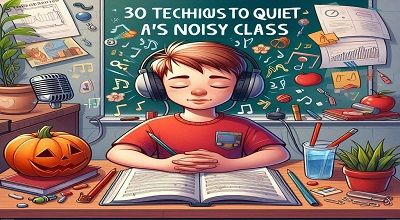Techniques to Quiet a Noisy Class
now here, 30 Techniques to Quiet a Noisy Class. Managing a noisy classroom can be challenging, but there are various techniques you can employ to promote a quieter and more focused learning environment. Here are 30 strategies to help you quiet a noisy class:
- Set clear expectations: Establish and communicate your classroom rules and expectations for behavior from the very beginning.
- Use non-verbal cues: Develop signals or gestures to communicate with students without speaking.
- Classroom layout: Arrange desks or seating in a way that minimizes distractions and encourages focus.
- Attention grabbers: Employ attention-getting techniques, such as clapping your hands, ringing a bell, or using a chime.
- Countdowns: Count down from 5 or 10 to signal that it’s time to quiet down.
- Call and response: Use call-and-response phrases where you call out a phrase and students respond in unison.
- Visual timers: Display a timer that counts down to the next activity or transition.
- Whispering: Speak quietly to encourage students to lower their voices to hear you.
- Reward systems: Implement a reward or incentive system for good behavior and participation.
- Music or white noise: Play soft, calming music or white noise in the background to reduce distractions.
- Seating charts: Assign specific seats to students to separate talkative individuals or create balanced groupings.
- Signal lights: Use a traffic light system to indicate noise levels, with red meaning silence, yellow for low volume, and green for normal conversation.
- Peer monitoring: Assign students to monitor their peers’ behavior and report back to you.
- Personalized goals: Set individualized goals for students to encourage self-regulation.
- Clear instructions: Ensure that instructions for activities or assignments are clear and concise.
More here…
- Hand signals: Teach students hand signals for various needs, such as a bathroom break or asking a question.
- Quiet activities: Provide students with quiet, independent tasks when they finish their work early.
- Brain breaks: Incorporate short breaks for physical activity or relaxation to help students refocus.
- Positive reinforcement: Acknowledge and praise quiet, on-task behavior when you see it.
- Classroom routines: Establish consistent daily routines and procedures to reduce chaos and confusion.
- Redirection: Gently redirect students’ attention back to the task at hand when they become off-task.
- Proximity: Move closer to noisy students to remind them to lower their voices.
- Class discussions: Encourage class discussions where students take turns speaking and listening.
- Group agreements: Have students participate in creating class agreements about behavior and respect.
- Conflict resolution: Teach students conflict resolution skills to handle disputes peacefully.
- Interactive lessons: Engage students in hands-on, interactive lessons to maintain their interest.
- Classroom signals: Develop signals to indicate when it’s time to listen, ask questions, or share.
- Peer support: Pair students who need help with those who can provide support during class.
- Parent communication: Keep parents informed about classroom behavior and seek their support.
- Stay calm: Maintain a calm and composed demeanor to model the behavior you want to see in your students.
Note:
30 Techniques to Quiet a Noisy Class. Remember that creating a quieter classroom environment takes time, consistency, and patience. Tailor your approach to your specific class and student’s needs, and be willing to adjust your strategies as necessary to promote a more focused and peaceful learning space.
